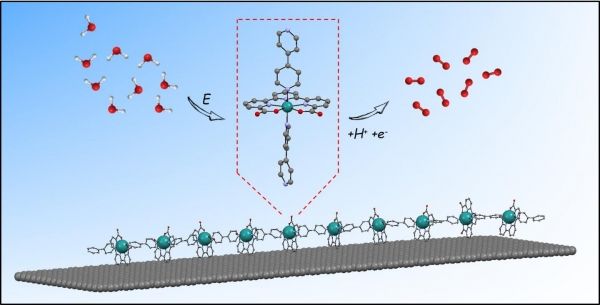Researchers from the Llobet group have developed a new molecular material made out of oligomers and used it as a catalyst in water oxidation, achieving unprecedented current densities for molecular catalysts. The paper “Water oxidation electrocatalysis using ruthenium coordination oligomers adsorbed on multiwalled carbon nanotubes” has been published in Nature Chemistry.
The generation of electro-anodes and cathodes for water splitting devices based on molecular complexes anchored onto solid surfaces is gaining traction thanks to their versatile and modular properties through ligand design. After studying the catalytic behaviour of oligomers of general formula {[Ru(tda)(4,4’- bpy)]n(4,4’-bpy)} (where n is 1, 2, 4, 5 or 15), the scientists from ICIQ’s Llobet team set out to anchor them onto graphitic surfaces. “We decided to design an oligomeric material based on our powerful Ru(tda) catalyst to move from homogeneous to heterogeneous applications. We had to anchor the catalyst on a surface to find a tangible application on water-splitting devices,” explains Marcos Gil-Sepulcre, postdoctoral researcher and group coordinator at the Llobet group and first co-author of the paper.
In collaboration with international partners such as Johannes Elemans at the Institute for Molecules and Materials Radboud University and Christina Scheu at the Max-Planck-Institut für Eisenforschung GmbH in Düsseldorf, the scientists carried out multiple Microscopy studies to characterize the hybrid materials. In addition, Grazing-incidence small-angle X-ray scattering (GIWAXS) was carried out at the Alba synchrotron by Marc Malfois and Eduardo Solano. Further, Density-functional theory (DFT) calculations, conducted by the ICIQ Maseras group, to explore the nature of the interaction between the oligomers and the graphitic surfaces. X-ray absorption spectroscopic (XAS) measurements were also employed, in collaboration with the group of D. Moonshiram at IMDEA Nanociencia, to analyse the oligomers at the graphitic surfaces, and evaluate their fate during and after catalysis. This way the researchers confirmed the molecular nature of the oligomer and found out that it is adsorbed to the graphitic surface via aromatic catalyst-surface C-H-π interactions – an anchoring strategy that has never been described for molecular catalysts up to now.
Read more at Institute of Chemical Research of Catalonia (ICIQ)
Image: Oligomeric catalyst (Credit: Marcos Gil-Sepulcre (ICIQ))


